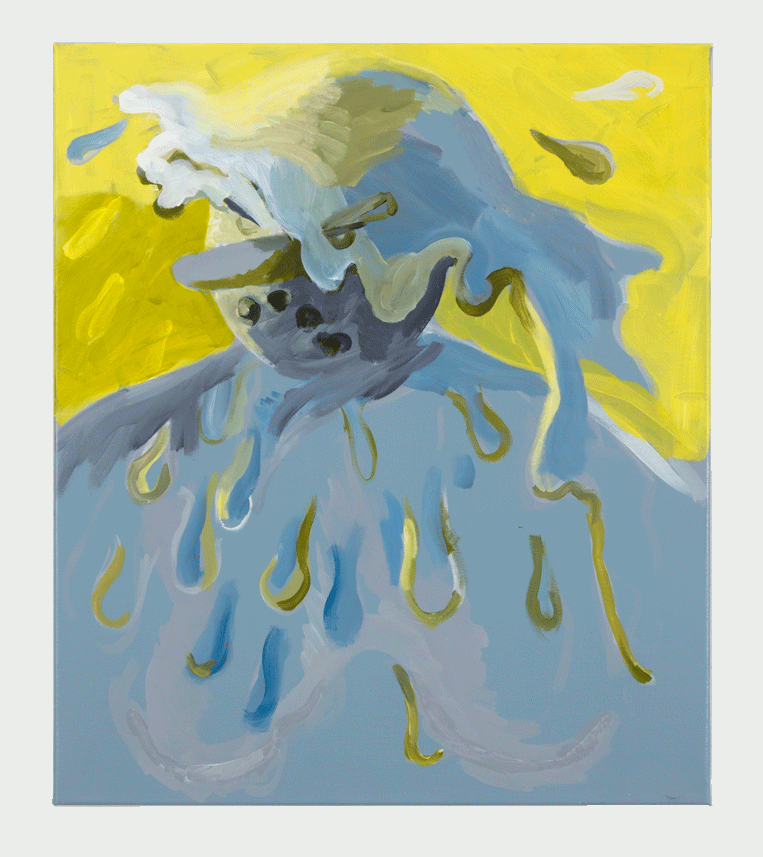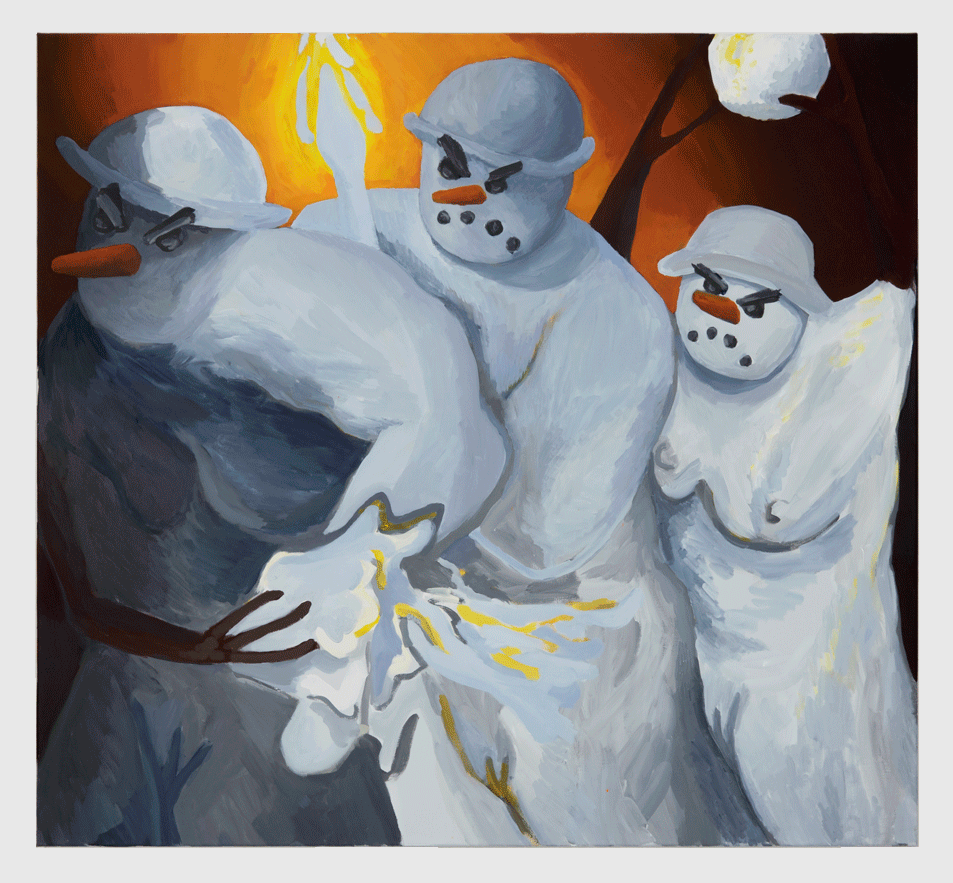If the earth’s melting polar ice caps were to assume a bodily form, it
would be a snowman. Swap flesh for snow, and mould the snow into arms,
legs, a face, a hat. Anything goes in the snow, so arms can be made of
snow or maybe twigs. Use coal and carrots for facial features because
they stand out.
A painter painting the snowmen imagines their scale. Are they tall, or broad? Are they as tall as a human painter? Squaring up to the canvas, the painter’s shoulders are as broad as the snowmen and her breasts are as loose. Painter to snowman proportions are about the same, you could look them in the eye if they would look back.
The painter piles up acrylic flesh to mix snow-tones: warm and cool greys, browns, blacks. Scraping greyish blobs of paint, she thinks: how buttocks roll, how abdomens and hips wobble and stack, she imagines how breasts hang, how biceps curl, how thighs plant themselves. These are FEMALE SNOWMEN occupying the painting space.
A painter painting the snowmen imagines their scale. Are they tall, or broad? Are they as tall as a human painter? Squaring up to the canvas, the painter’s shoulders are as broad as the snowmen and her breasts are as loose. Painter to snowman proportions are about the same, you could look them in the eye if they would look back.
The painter piles up acrylic flesh to mix snow-tones: warm and cool greys, browns, blacks. Scraping greyish blobs of paint, she thinks: how buttocks roll, how abdomens and hips wobble and stack, she imagines how breasts hang, how biceps curl, how thighs plant themselves. These are FEMALE SNOWMEN occupying the painting space.

If you are a female snowman then your flesh is snow. Your body is
elemental, as snow is frozen crystallised water. Water can freeze,
crystallise, vaporise. Snow can melt.
To change water into a different state, the surrounding temperature has to change. If the exterior temperature rises, then maybe you begin to melt. But what happens when your interior temperature warms? If you were an angry female snowman, would you sweat?
Female snowmen have reasons to be angry. They wear a monotone expression like this: coal eyes glinting under furrowed coal brows, peaked at an alarming angle that escapes the brim of the hat. In the middle, an orange carrot nose pokes out. The mouth is neatly spaced coals, curving downwards into a frown.
We can’t see the target of their rage. They all look to our left, out of the painting frame: the enemy is absent. From our perspective, it’s impossible to meet their gaze. Their anger is distant, unable to hurt us. We are looking at a picture of anger, not anger itself.
Anger isn’t narrative. If I have a dream in which I am angry, I am smashing up objects, burning things, attacking without inhibition and with the only goal of destroying the target of my anger. Like an enraged beast charging in a straight line. Anger is white noise, like snow. It’s one-directional like the vision of these female snowmen, all looking to the left.
If a female snowman wants to attack the object of her anger, she has many weapons at her disposal. She has snowballs, ice-shards; she can stealthily climb onto an ice floe or hide in blue icy water. Her snowy surroundings offer ample material for weaponry and defence. And when her surroundings are depleted, she can tear a snowball out of her own flesh and fling it, hard.
To change water into a different state, the surrounding temperature has to change. If the exterior temperature rises, then maybe you begin to melt. But what happens when your interior temperature warms? If you were an angry female snowman, would you sweat?
Female snowmen have reasons to be angry. They wear a monotone expression like this: coal eyes glinting under furrowed coal brows, peaked at an alarming angle that escapes the brim of the hat. In the middle, an orange carrot nose pokes out. The mouth is neatly spaced coals, curving downwards into a frown.
We can’t see the target of their rage. They all look to our left, out of the painting frame: the enemy is absent. From our perspective, it’s impossible to meet their gaze. Their anger is distant, unable to hurt us. We are looking at a picture of anger, not anger itself.
Anger isn’t narrative. If I have a dream in which I am angry, I am smashing up objects, burning things, attacking without inhibition and with the only goal of destroying the target of my anger. Like an enraged beast charging in a straight line. Anger is white noise, like snow. It’s one-directional like the vision of these female snowmen, all looking to the left.
If a female snowman wants to attack the object of her anger, she has many weapons at her disposal. She has snowballs, ice-shards; she can stealthily climb onto an ice floe or hide in blue icy water. Her snowy surroundings offer ample material for weaponry and defence. And when her surroundings are depleted, she can tear a snowball out of her own flesh and fling it, hard.

Perhaps the only way to protect land from destruction is to radically
identify with it. Female snowmen are made of the same substance as
their surroundings—snow. They identify with their land; they are one
and the same. They can use their surroundings as a tool and when that
runs out they can use their bodies. Female snowmen know this,
instinctively.
For the female snowmen, giving up the body is not self-destruction or self-exploitation as much as it is self-use. In fact, for female snowmen it is not a question of a self or a body, but rather the body politic.
When material meets narrative, cause and effect gets confused. The laws of cartoon physics are disturbed by the flows of thick paint. The icon of anger is forgotten in the struggle and pleasure of painting. Is the figure melting or sweating? Or is the paint still wet?
Materials are always in conflict with narrative, in the same way that flesh wrestles with politics. An artist paints displeasure and laughs. A woman at a protest march becomes dehydrated and her face swells up like a snowman. What is the story of my material body when it is confronted in public? Are the materials of the body a resource for political action?
Giving up your body makes perfect sense when the world is also your body. Female snowmen don’t die as long as there is still snow. When all the snow melts that will be their true extinction. It will probably be ours, too.
Until that day—or until the day we radicalise as female snowmen—they will keep on firing snowballs. They will light up the dark night with flaming ice.
For the female snowmen, giving up the body is not self-destruction or self-exploitation as much as it is self-use. In fact, for female snowmen it is not a question of a self or a body, but rather the body politic.
When material meets narrative, cause and effect gets confused. The laws of cartoon physics are disturbed by the flows of thick paint. The icon of anger is forgotten in the struggle and pleasure of painting. Is the figure melting or sweating? Or is the paint still wet?
Materials are always in conflict with narrative, in the same way that flesh wrestles with politics. An artist paints displeasure and laughs. A woman at a protest march becomes dehydrated and her face swells up like a snowman. What is the story of my material body when it is confronted in public? Are the materials of the body a resource for political action?
Giving up your body makes perfect sense when the world is also your body. Female snowmen don’t die as long as there is still snow. When all the snow melts that will be their true extinction. It will probably be ours, too.
Until that day—or until the day we radicalise as female snowmen—they will keep on firing snowballs. They will light up the dark night with flaming ice.
Contributors
Félicia Atkinson
Carlotta Bailly-Borg
Feiko Beckers
Piero Bisello
Dina Danish
Simona Denicolai & Ivo Provoost
Filarowska
Eric Giraudet de Boudemange
Francesca Grilli
Rumiko Hagiwara
Henrik Olai Kaarstein
Bitsy Knox
Aukje Koks
Frank Koolen
Gwendolyn Lootens
Chaim van Luit
Lorna Macintyre
Perri MacKenzie
Jean-Baptiste Maitre
Hana Miletić
Anna Muchin
Scarlett O'Hanna
Kwasi Ohene-Ayeh
Anouchka Oler
Sahar Saâdaoui
Sam Samiee
Daniel van Straalen
David de Tscharner
Yann Vanderme
Carlotta Bailly-Borg
Feiko Beckers
Piero Bisello
Dina Danish
Simona Denicolai & Ivo Provoost
Filarowska
Eric Giraudet de Boudemange
Francesca Grilli
Rumiko Hagiwara
Henrik Olai Kaarstein
Bitsy Knox
Aukje Koks
Frank Koolen
Gwendolyn Lootens
Chaim van Luit
Lorna Macintyre
Perri MacKenzie
·What is anger about?
Hana Miletić
Anna Muchin
Scarlett O'Hanna
Kwasi Ohene-Ayeh
Anouchka Oler
Sahar Saâdaoui
Sam Samiee
Daniel van Straalen
David de Tscharner
Yann Vanderme
